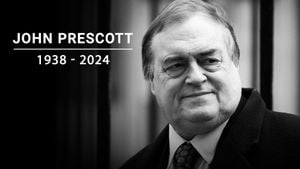On the night of November 16, 2024, the electric atmosphere at the AT&T Stadium in Arlington, Texas, buzzed with excitement as boxing fans gathered for one of the most anticipated matches of the year. The legendary Mike Tyson, at the ripe age of 58, returned to the ring to face 27-year-old YouTube sensation and budding boxer Jake Paul. The encounter promised not only to be a showdown between two starkly different styles but also an exploration of generational conflict within the boxing world.
This grand spectacle attracted 72,000 spectators, contributing to an astounding $18 million gate, solidifying this match as much more than just another fight; it was also a blockbuster entertainment event. But as the bell rang and the two fighters exchanged blows over eight two-minute rounds, fans and critics alike became observers of Tyson’s resilience and Paul’s youthful vigor.
From the outset, Tyson struck with intention. The former heavyweight champion threw powerful jabs, reminding the crowd of his explosive past. Despite being almost three decades older than Paul, he demonstrated flashes of the old ferocity, connecting solidly during the initial rounds. Yet as the fight wore on, it became increasingly clear how age weighs on the body. After Tyson’s strong showing early on, particularly landing solid punches with his characteristic left hook, he gradually found it more difficult to keep pace with Paul.
By the end of the match, Jake Paul, recognized for his skills honed from virtually living as the center of attention and social media’s obsession, had successfully outmaneuvered the aging champion. He earned the unanimous decision victory from the three judges, each scoring the contest decisively for Paul, who landed over seventy punches compared to Tyson’s eighteen. The obvious age difference, reflected increasingly throughout the fight, left many wondering about the ethics of such matchups.
Post-match, Paul expressed admiration for Tyson, stating, “Tyson is a legend. It was an honor. I wouldn’t be here without him,” punctuating the sentiment with a heartfelt bow to his opponent, acknowledging the long shadow the former champion casts over the sport. Tyson, embodying the spirit of competitors who refuse to concede effortlessly, commented, “I’m happy. I didn’t have to prove anything to anyone, just to myself.” His self-awareness did not go unnoticed, lending him grace even as he faced defeat.
Attending the bout were several celebrities—Charlize Theron, Sugar Ray Leonard, and even Italian actress Elisabetta Canalis. The crowd was diverse, consisting of both boxing purists and fans who tuned in primarily for the spectacle. The fight not only drew the attention of live audiences but also commanded the imaginations of online viewers around the globe, primarily through Netflix, which hosted the streaming rights. Unfortunately, the live stream faced significant technical challenges, with numerous complaints surfacing about buffering and connection issues.
Before the match began, Tyson made headlines when he slapped Paul during the pre-fight weigh-in, triggering speculation about the competitors’ tension. This incident sharply contrasted the camaraderie displayed at the end of the match, where both men embraced after sharing the ring. Such moments reflect the paradox at play; the fight was as much about entertainment as it was about sport, with each opponent bringing their brand of combat to the event.
Critics immediately weighed in on the quality of the contest. Some media outlets labeled the match 'slow and boring', likening it to more of a show than serious competition. Terence Crawford, another notable boxer, was vocal, stating, “I love Tyson, but he was getting too much credit. It’s insane to see someone train so long and only throw 97 punches throughout the fight.” This raises questions about how we judge our champions and whether modern-day bouts like these overshadow traditional boxing legacies.
Another controversy arose during the match itself. Tyson wore his knee brace throughout, hinting at physical limitations which spoke volumes about his remarkable return to the sport. Critics juxtaposed his legendary status with the reality of aging, fueling debates about the validity of boxing matches involving older athletes against younger opponents. Has the line between sport and spectacle been blurred? Many asked if Tyson's heart and spirit could stand against the practicalities of conditioning and skill adoption by younger fighters like Paul.
The business surrounding celebrity boxing seems to be thriving; the combination of real athleticism with entertainment spectacle evokes mixed predictions for boxing’s future. Will this become the new norm for boxing events? Jake Paul, originally seen as merely exploiting his YouTube fame, has now transitioned to serious competition and boasts ten professional wins with only one loss. His bold claims and unyielding persona have transitioned him from social media antics to respectable athlete commentary.
Looking forward, Jake Paul’s future appears promising and filled with potential opponent matchups, including discussions of high-stakes bouts against professional fighters. Meanwhile, Mike Tyson remains vitally important to boxing history, not just as a former champion but as someone who embodies what it means to fight against the odds, whether they be against opponents or the passage of time itself.
While many might have originally viewed the heavyweight clash as merely celebrity fanfare, it touched on generational themes prevalent today within sports culture; the essence of legacy, the impact of fame, and what it means to truly compete. Tyson and Paul each carried with them elements of boxing’s storied past compatible with the present chaotic spectacle. Independent of the victor, both have left indelible marks on the sport, reminding fans why boxing continues to be cherished across generations. Perhaps it's about acknowledging the spirit of competition itself, expressed through both skill and courage, regardless of the age or status of the fighters involved.



